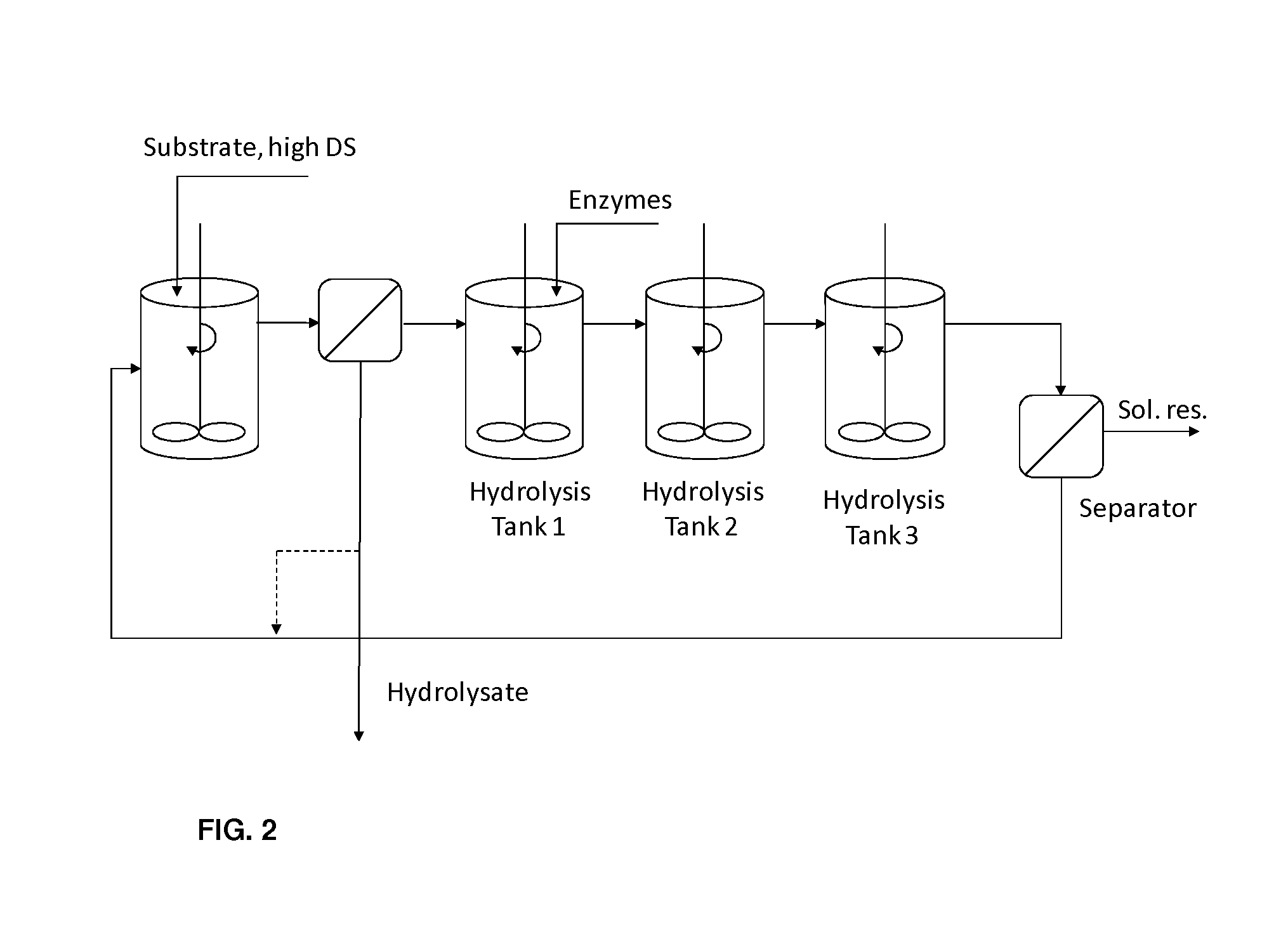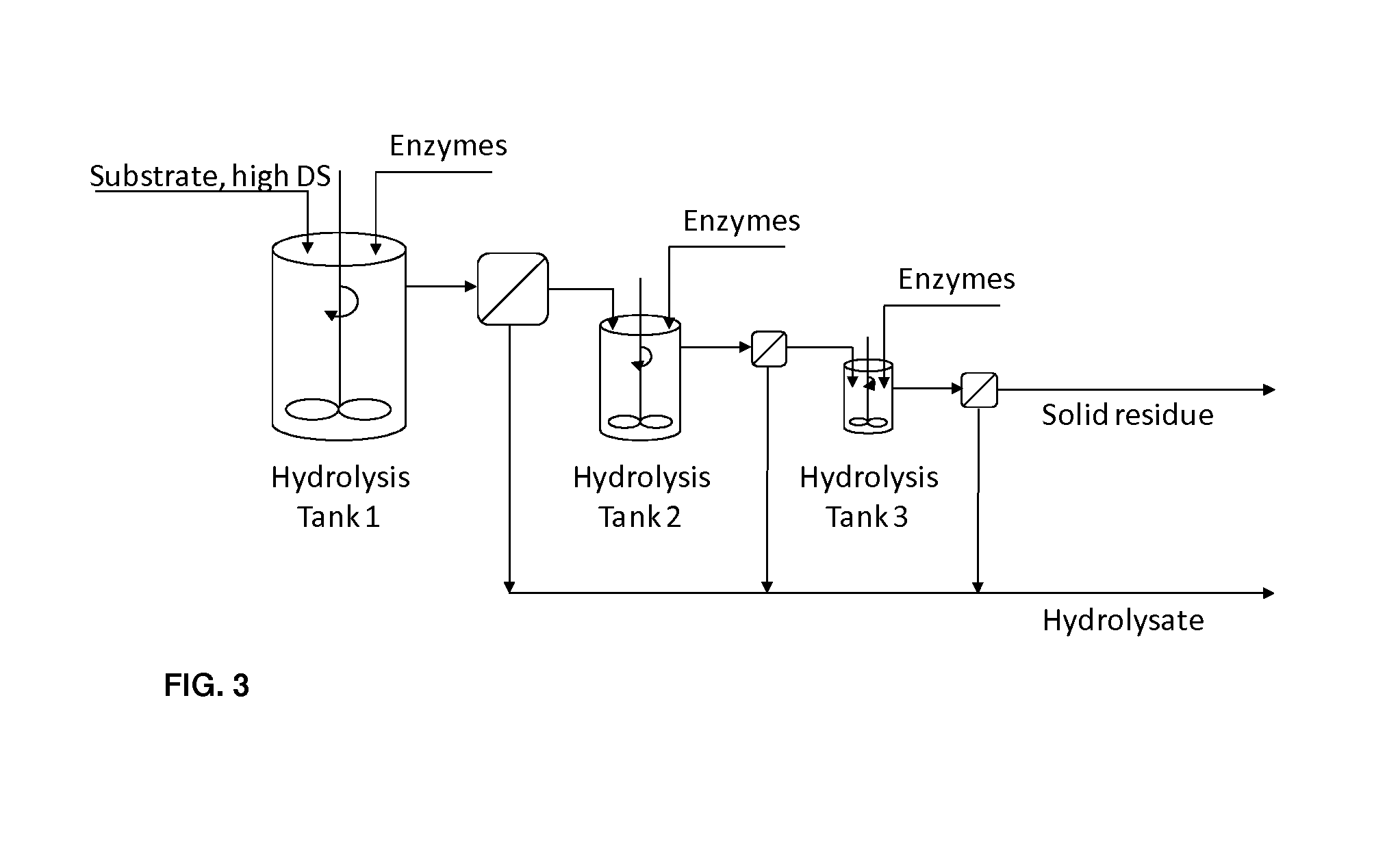Enzymatic hydrolysis of cellulose
a technology of cellulose and cellulose, which is applied in the direction of glucose production, biomass after-treatment, fuels, etc., can solve the problems of crystalline structure, inability to easily hydrolyze, and food shortages and price increases, so as to reduce cellulase loading and high solid content cellulosic biomass, the effect of minimizing (investment and operation) costs
- Summary
- Abstract
- Description
- Claims
- Application Information
AI Technical Summary
Benefits of technology
Problems solved by technology
Method used
Image
Examples
example 1
[0120]To determine the approximate average retention time of a first reactor, one sample of alkaline sulfite cooked bagasse substrate prepared similarly to conditions described in Example 1 of WO 2010 / 078930 was hydrolyzed. The hydrolysis was conducted in a Physica MCR 101 rheometer in a cup with a stirrer (FL 100 / 6 W). The rotational speed was 30 rpm and temperature 50° C. The cellulosic biomass concentration was 10% and the enzyme addition was 40% V / w of Accellerase Duet (Genencor, Calif., USA). The viscosity was continuously monitored and the viscosity as a function of time is shown in FIG. 4.
[0121]The hydrolysis results in an initial rapid decrease in viscosity and, after a short period of time, the viscosity curve starts to flatten out and reaches a level where the sample can be seen as a liquid or liquid-like. This viscosity is dependent on the substrate (here: cellulosic biomass) and the experimental conditions, but the hydrolyzed material can be considered to be liquefied wh...
example 2
[0123]A sample of acid sulfite cooked bagasse substrate (bagasse pulp), prepared under similar conditions as described in Example 2 of WO 2010 / 078930, was subjected to continuous hydrolysis in an experimental set-up with 3 reactors in series as depicted in FIG. 6. The total volume of the system was measured to be approximately 6.6 liters. The reactors were mantled and connected to a water bath for temperature control, and cooling water was circulated in the lids to minimize evaporation from the reactors.
[0124]Enzymes (Accellerase DUET from Genencor, Calif., USA), buffer (Sodium acetate buffer, 50 mM concentration in the reactors at steady state) and the bagasse pulp were continuously added to reactor 1. The reaction mixture was kept at 50° C. in reactors 1 to 3. The hydrolysate was collected in the product tank that was water cooled to about 5° C.
[0125]The average total input to the system was 144.2 g / h. The average dry substrate concentration in the input was 17.1% and the average ...
example 3
[0128]A sample of alkaline sulfite cooked bagasse substrate (bagasse pulp) prepared under similar conditions as the ones described in Example 1 of WO 2010 / 078930 was subjected to hydrolysis in an experimental set-up with 3 reactors in series as depicted in FIG. 6. The total volume of the system was measured to be approximately 6.6 liters. The reactors were mantled and connected to a water bath for temperature control, and cooling water was circulated in the lids to minimize evaporation from the reactors.
[0129]Enzymes (Accellerase DUET from Genencor, Calif., USA), buffer (Sodium acetate buffer, 50 mM concentration in the reactors at steady state) and the bagasse pulp were continuously added to reactor 1. The reaction mixture was kept at 50° C. in reactors 1 to 3. The hydrolysate was collected in the product tank that was water cooled to about 5° C.
[0130]The average total input to the system was 144.1 g / h The average dry substrate concentration in the input was 18.8% and the average e...
PUM
| Property | Measurement | Unit |
|---|---|---|
| viscosity | aaaaa | aaaaa |
| temperature | aaaaa | aaaaa |
| viscosity | aaaaa | aaaaa |
Abstract
Description
Claims
Application Information
 Login to View More
Login to View More - R&D
- Intellectual Property
- Life Sciences
- Materials
- Tech Scout
- Unparalleled Data Quality
- Higher Quality Content
- 60% Fewer Hallucinations
Browse by: Latest US Patents, China's latest patents, Technical Efficacy Thesaurus, Application Domain, Technology Topic, Popular Technical Reports.
© 2025 PatSnap. All rights reserved.Legal|Privacy policy|Modern Slavery Act Transparency Statement|Sitemap|About US| Contact US: help@patsnap.com



